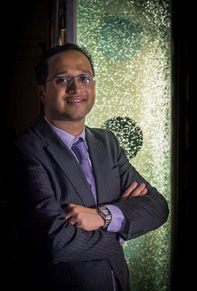Light particles in turbulence
Promotion date: September 26.
Promotor: prof. dr. rer. nat. Detlef Lohse
Assistent promotor: Dr. Chao Sun
| Particles in a turbulent fluid flow are modeled to understand many systems to enable predictions, for example, the ash release due to the recent volcano eruption (Eyjafjallajökull, 2010), which caused major air-travel disruption around northern Europe. In this thesis, the dynamics of light particles (air bubbles and rigid hollow spheres in water) in turbulence is studied, which is an unexplored regime in current literature. The focus is on understanding the effects of density, finite-size and gravity, void fraction, deformability and sphericity. Experiments have been carried out in a unique large-scale, multi-phase turbulence facility (Twente Water Tunnel), which is eight meters high. Challenging techniques are implemented like: 3D Lagrangian Particle Tracking, a moving sled-based particle tracking system, and phase-sensitive constant temperature anemometry. The experimental results have been compared to state-of-the-art numerical simulations from collaborators around Europe. |
Was your research fundamental in nature?
The research was fundamental in nature, however, concerning general phenomena and problems. Industry and FOM funded this research in which different project teams are collaborating. A lot of industrial processes involving multi-phase processes are still poorly understood, for example using air in an efficient way, during the production process of pure steel. Among the funders are: Shell, Akzo Nobel, Tata Steel and DSM. During my work I constantly felt the industry partners were very interested to understand these processes better, in order to enhance performances in production.
The Twente Water Tunnel, where I conducted experiments, is a very powerful setup that can be used to verify certain theoretical predictions and results obtained from advanced simulation runs. This unique turbulence setup combined with the experimental techniques I implemented, on plenty of occasions yielded nice results. By analyzing the experimental images, we saw new effects, never foreseen by theory nor predicted by simulation runs or numeric calculations. These experiments led to new inputs for numerical simulations, and the observations revealed very new physics. A research group in Sweden has been motivated to construct new theoretical constructs using our data. This clearly shows that the reputation of Mesa+ and the Physics of Fluids Group is taken seriously worldwide.
So, you collaborated in an intense way during your PhD work?
Yes, very much so. First of all, at our group we work on these kinds of topics in a big team. Many different projects are involved. This leads to high-quality papers that are published with contributions from many authors. I cherish the moments when everybody in the team sat together to write these papers all the way to the end stage, discussing and figuring out solutions to problems immediately. This was a very enjoyable and efficient way of working. I learnt a great deal about how successful collaborations can result in outstanding scientific contributions.
Numerical simulations and modeling are very important in this field of research. We were collaborating on this with colleagues from France (Université Lille) and TU Eindhoven. In our team, a post-doc, an assistant professor, another PhD student and myself worked on this on a daily basis. Some of them have direct contact with members of industry, trying time and time again to rephrase the subject matters that are of relevance. The research has a long-term impact. I am sure new insights and application ideas will come out of it in the future.
Did you manage to have some nice publications?
Four papers are published already, and a fifth one is submitted. Two were published in the Journal of Fluid Mechanics, one in the Physics of Fluids, and one in the New Journal of Physics, which are all top journals in the field.
In what way did you develop as a scientist and researcher?
I was very privileged being invited by the famous professor Detlef Lohse to join his group, whilst we met at a conference. I immediately accepted his nice offer. Working on the PhD project changed my way of thinking about research, going deep into literature, to design and conduct new experiments based on the knowledge available there. Also, I have built on my own knowledge and curiosity, and learned to pose open questions and answer them. Now I am an experienced researcher.
What are your future plans?
First of all I am going to work here in a post-doc position for a few months, finishing some promising experiments and writing some more articles. Also, I am going to help the PhD student who will continue my work here. I would like to give him a solid knowledge base.
After this I am going to work as a post-doc at Stanford University in California, USA. There, I will apply my knowledge and expertise in fluid dynamics to a field that is more biology oriented; I will investigate the physical origins of multicellularity. I am sure that my experimental training and experience will be of help there, and I hope to learn more about biology. I believe that this is an important step in my career. In the future, it would be great to lead my own research group; perhaps in Europe or in the USA, or even in my home country of India, only time will tell.
Links:
‘New Journal of Physics (NJP) Video Abstract Prize 2013’
- Featured on UT News: "UT RESEARCHERS WIN NJP VIDEO COMPETITION"
http://www.utwente.nl/en/archive/2013/08/ut-researchers-win-njp-video-competition.docx/
- Featured on NJP front page: www.njp.org
- Two turbulence facilities join European research network - EuHIT (European Hi-performance Infrastructures in Turbulence), Featured on UT News:

